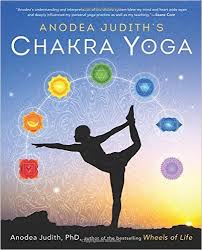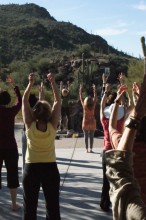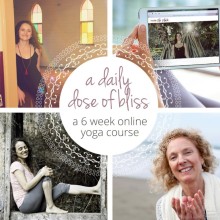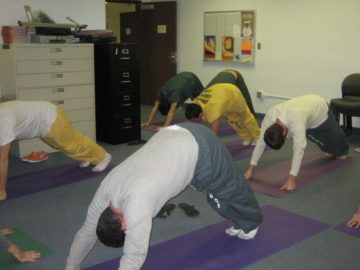In this newsletter, we report on important research about the benefits of yoga for schizophrenia. There are also two studies that look at the benefits of yoga for inmates in prison, a review of a new book by Anodea Judith, PhD, and a new yoga curriculum for Jewish children. There is also news about the next residential LifeForce Yoga Practitioner Training.
Research: Prisoners Benefit from Yoga and So Do Their Children
 There are two recent studies that look at the benefits of Yoga in Prisons. The first study measures “dosage”–the effects on the prisoners themselves based on how often they practiced. The second looks at how participation in yoga affects their parenting skills.
There are two recent studies that look at the benefits of Yoga in Prisons. The first study measures “dosage”–the effects on the prisoners themselves based on how often they practiced. The second looks at how participation in yoga affects their parenting skills.
In the first study, published in Evidence-Based Complementary and Alternative Medicine, researchers provide evidence that yoga offers progressive, beneficial anti-stress benefits to members of a prison population.
The research corroborates an earlier study by the same authors showing that yoga in this population improved both mental well-being and cognition. Improved performance on a cognitive task was also observed among prisoners who took part in the yoga intervention compared to control participants. The researchers wanted to dig deeper to find what might underpin the beneficial effects of yoga. They did this by testing the effects of not just attendance of yoga sessions, but by the frequency of those sessions.
When class attendance is low, the ‘dose’ of the intervention may be considered reduced, and the intervention may fail to deliver full benefits,” the study authors observed, “…we also tested whether frequency of self-practice had an influence on participants’ mood, levels of stress, and psychological distress.
The current study followed 87 prisoners (81 male, 6 female) in West Midland prisons, 26 of whom served as controls. The yoga course consisted of a total of 10 two-hour classes, once per week for 10 weeks. Classes consisted of a standardized set of hatha yoga postures. Each class ended with a period of relaxation and meditation. The researchers then conducted a series of multiple linear regression analyses to determine whether the number of yoga classes attended contributed to explaining the variance in psychological outcomes, after statistically controlling for demographic variables and key baseline psychometrics.
They found that greater improvement in the form of decreased stress was significantly related to greater yoga class attendance. Higher levels of self-practice (five times or more per week) were also related to reduce perceived stress and negative affect.
Whether the key benefits of yoga interventions are specifically linked to elements of the yoga practice (poses; breathing techniques; meditation) or broader elements such as the social aspects of yoga practice, this class/group intervention has clearly demonstrated mood improvement and reduced stress.
In the second study, published in the August edition of the California Journal of Health Promotion, inmates who practiced yoga demonstrated being more aware and accepting of their vulnerability and responsiveness to children, among other benefits.
The yoga intervention was combined with a class on child development. “We would have a class on a specific topic, like child development or setting limits,” said study author Jennifer Crawford. “That would last about an hour, then a yoga instructor would come in and give a guided yoga class.”
The study, located at Chelan County Regional Jail in Wenatchee, Washington, took place over three years with 14 different groups of male inmates. The program was advertised among the jail population; volunteers, who had to be parents of young children and pass a security screening, were recruited.
The program, called “Fit Fathers, Successful Families, Inside and Out,” had a goal of preventing child abuse and reducing recidivism by improving parents’ resilience.
“Yoga can be physically demanding, and the initial responses we got from the participants confirmed that,” Crawford said. “I believe the yoga practice helped participants become ready to learn and increased their willingness to try new ideas, absorb new information and begin to apply these in their lives.”
Research: Yoga Benefits Schizophrenia
This is an important study! It is from the prestigious Cochrane Review that is, according to LifeForce Yoga Practitioner and Teacher Trainer Heather Mason, Director of Yoga Therapy for the Mind at the Minded Institute in the UK who first posted this, “internationally famous for their rigor.” The review found that although more research is needed, yoga may be better than standard care for those suffering from . The researchers are conservative in recommending yoga, because the yoga studies are weak as compared to the better resourced studies, mostly funded by pharmaceutical companies.
Still, this helps lay the foundation for scientific validation of what we have been practicing and teaching. As the validation gets stronger, this means that more precious beings diagnosed with serious mental illnesses like schizophrenia will be seeking out and being referred to yoga classes, yoga ashrams, and yoga centers.
This makes it vital that yoga and mental health professionals take trainings like the LifeForce Yoga Practitioner Training and that they learn to collaborate with each other. It also means that spiritual centers need to be prepared for this population, which may take more care than the traditional precautions and protocols regarding Kundalini awakening experiences.
Review: Shalom Kids Yoga—A Curriculum for Jewish Education

LifeForce Yoga Practitioner Jory Stillman has developed a strong and empowering yoga curriculum for Jewish education called Shalom Kids Yoga (SKY): Bereishit Yoga Curriculum, based on the story of Creation in the Hebrew Bible, known as the Torah. The format for each class includes teaching notes and ways to introduce Torah. Jory suggests that the teacher encourage her students to develop the class standards, which she calls, Shalom Ba’Kita (Peace in the Classroom) and then to hang them up in the room.
This is a rich curriculum, with Torah text time, class flows of yoga poses named in Hebrew to represent the creation of the elements, and beautiful self-inquiry questions to ponder and discuss. Every class includes a Kabbalistic Minute of quiet contemplation on a theme. In each of the seven sessions, there are discussion questions, an opening centering meditation, warm-ups, breathing practices, yoga poses (about 40 minutes worth) and a guided relaxation that is woven into the theme of the class.
Jory includes Shalom Kids Yoga art activities as well as games and stories and encourages teachers to be creative, resequencing the class or adding their own elements.
Not only is this curriculum a peaceful and fun way to introduce children to a deeper contemplation of Torah, but it is a way to give them yoga skills that research has shown can reduce stress and create greater resiliency, self-regulation, and well-being. If you would like more information about this brilliant curriculum for Jewish education, contact Jory Stillman at info@shalomkidsyoga.com, or visit http://jorystillman.com/shalom-kids-yoga/.
Review: Chakra Yoga by Anodea Judith

Psychologist and yogin Anodea Judith is an amazing resource when it comes to the chakra system. Her first book, Wheels of Life: A User’s Guide to the Chakra System, has become a yoga classic. Now she has released a book specific to hatha yoga practice using the chakras. This is a great resource for individuals who may wish to focus their practice on a specific chakra, as well as a manual for teachers who wish to lead a chakra yoga practice. Chakra Yoga can be used by novices who would like to learn about the chakras, experienced practitioners looking for ideas or perspective, and everyone in between. To put everyone on the same page, Judith gives a concise and thorough explanation of the chakras.
Judith gives a short introduction, where she introduces the reader to her personal and professional experience with chakras. She then places the chakras into the context of yoga (some may have encountered chakras at the new age store and not know their yogic origins). Yoga means “to yoke,” or hitch two things together and Judith says, “the chakra system is the architecture of that yoke, providing a comprehensive map to the way the mortal and the Divine yoke together.” The goal of the chakra, yoga, and LifeForce Yoga is wholeness and integration. The chakra system “provides both a ladder for liberation and a map for manifestation.” Understanding our chakras and integrating this knowledge into our practices, allows us to have a deeper experience of focus and unfolding.
Each chapter is devoted to a specific chakra and begins with a chart of the basic principles of that chakra. These principles include things like associated element, body parts, practices, actions, deficiencies, balances, etc. Judith identifies a keyword for each chakra, which is elaborated upon in the discussion of basic concepts that follows. As an example, the keyword for Manipura, third chakra, is activate, through the cultivation of fire (agni) in the body. This concept of activation through fire is put into context with a discussion of the underlying yogic philosophy with sources from the Yoga Sutras of Patanjali and the Bhagavad Gita. The author then grounds this discussion into an experience, pelvic pulsing for the second chakra, uddiyana bandha (energy lock) for the third chakra, etc. The energy practice is followed by a meditative experience, a subtle energy exploration of the chakra.
The chapter continues with a yoga posture flow. Judith states in the introduction that there is no substitute for a skilled teacher and since this is not a comprehensive yoga pose manual, she has made some wonderful adjustments. Postures have a basic set of step by step instructions and readers are asked to follow them in order without omission. Guidelines are given for further instruction, as well as benefits and cautions. At the end of the chapter, a posture flow is given with the names of the poses and a small photograph. The selection of which postures to include is not easy as postures influence more than one chakra at a time, or variations of the same pose, or a shift in focus, may impact a different chakra. For this reason, Judith states, “some of the basic poses will appear in more than one chakra.” Of special note: the author provides a four pose partner yoga sequence in the heart chakra chapter.
Judith provides a specific relaxation and focus for each chakra. For example, the focus of relaxation for the fifth chakra (visshudha at the throat) is on “listening to the subtle variations coursing throughout the whole body.” The relaxation focus for the first chakra (muladhara at the base of the spine) is on feeling the solidity of the body and receiving nourishment from the earth.
Judith is adept at writing about complex concepts from yoga philosophy so that they are easy to understand and yet lose none of their richness. Chakra Yoga contains ample opportunities to experience energy, movement, and stillness. It belongs on the shelf of every yoga/chakra enthusiast.
This book is a great addition to the LifeForce Yoga library. Judith, a Kripalu Yoga teacher like Amy Weintraub, provides a compendium of yoga postures associated for each chakra. In LifeForce Yoga chakra sounds are used in posture, in addition to other practices, to affect the mood. This book offers more information on the chakras and other options for posture.
Purchase a copy of Chakra Yoga
News: Vets with PTSD Benefiting from LifeForce Yoga
 LifeForce Yoga (LFY) is making a difference in the lives of veterans suffering from PTSD. In the new program, run by trauma therapist and LifeForce Yoga Trainer Randy Todd, LCSW, MSW LFYP-2, veterans diagnosed with PTSD have been provided the option of participating in a weekly, coed, 90-minute LifeForce Yoga group. Todd introduced the LFY protocol to the Southern Arizona VA Health Care System in Tucson in early 2015 and it was integrated into the PTSD treatment program, beginning in March 2015. The group consists of movements, breathing techniques, intention setting, affirmations, visualizations, and Yoga Nidra practice. Mats are optional.
LifeForce Yoga (LFY) is making a difference in the lives of veterans suffering from PTSD. In the new program, run by trauma therapist and LifeForce Yoga Trainer Randy Todd, LCSW, MSW LFYP-2, veterans diagnosed with PTSD have been provided the option of participating in a weekly, coed, 90-minute LifeForce Yoga group. Todd introduced the LFY protocol to the Southern Arizona VA Health Care System in Tucson in early 2015 and it was integrated into the PTSD treatment program, beginning in March 2015. The group consists of movements, breathing techniques, intention setting, affirmations, visualizations, and Yoga Nidra practice. Mats are optional.
Mental health staff have also been able to take advantage of LifeForce Yoga. Two, one-hour in-service trainings were offered in May and August. As an outgrowth of the first training, a weekly Yoga Nidra practice is now offered to professional staff every Wednesday over lunch to promote their own self-care.
It has been an exciting and rewarding experience, offering LifeForce Yoga to both our veterans and professional staff, says Todd, Their feedback about the experience has consistently been positive.Indeed, here are some recent comments from participating veterans: “I had no idea it could be so good!This is one of the best experiences I’ve had!it is so very relaxing!I have a better sense of overall well-being!”
 Randy Todd, LCSW, MSW LFYP-2, will be on faculty for the LifeForce Yoga Practitioner Training, January 10 – 17, 2016. Here’s what Randy said about his own experience:
Randy Todd, LCSW, MSW LFYP-2, will be on faculty for the LifeForce Yoga Practitioner Training, January 10 – 17, 2016. Here’s what Randy said about his own experience:
I found Level I LFY training to be an excellent opportunity for skill acquisition and practice, attainment of greater self-awareness and personal growth, and the potential to develop relationships with other colleagues from around the country (and beyond). My Level 1 training has taken my own personal practice of yoga to a much higher level. You’ll find it to be a full week of classes, practices, and experiences – a week that will go amazingly fast. There will many things to enjoy and to take with you – one will be experiencing some of the best sunrises in the Southwest! I look forward to meeting you in January!
For more information about this training, with a certification track for health care providers (CEU’s), yoga teachers and open to yoga practitioners, visit http://yogafordepression.com/practitioner-training/.
News: Dates for First LifeForce Yoga Practitioner Training in Australia Announced
For the first time ever, the LifeForce Yoga Practitioner Training will be held May 6-10th in Melbourne, Australia. We are thrilled to be bringing this training to an international audience!
News: Amy is a Guest Teacher on A Daily Dose of Bliss
I  just wanted to share with you today an online yoga course in which I’m teaching. It’s a six week course specifically designed to teach you practices to stay calm, centered and grounded, amidst the ups and downs of daily life. In A Daily Dose of Bliss, you’ll receive a new 5-10 minute practice each day for six weeks. The course was lovingly created by Dr Lauren Tober, a Clinical Psychologist and Yoga Teacher from Byron Bay, Australia. And I’m honored to be joining her and a host of internationally acclaimed yoga teachers to help you to find your bliss!
just wanted to share with you today an online yoga course in which I’m teaching. It’s a six week course specifically designed to teach you practices to stay calm, centered and grounded, amidst the ups and downs of daily life. In A Daily Dose of Bliss, you’ll receive a new 5-10 minute practice each day for six weeks. The course was lovingly created by Dr Lauren Tober, a Clinical Psychologist and Yoga Teacher from Byron Bay, Australia. And I’m honored to be joining her and a host of internationally acclaimed yoga teachers to help you to find your bliss!
The early bird price is available for just a little while longer.
Trainings and Workshops
Click below to find a LifeForce Yoga Training or Workshop near you!

I absolutely love your site.
I would love to work for you.
I live in Chicago and an a certified yoga instructor and 50 hours kids certification.
I believe that mental health is very important and have been trying to find the right opportunity to do work in the areas I know best
Thank you for your kind words about our site. You might look into training with us, Stacy, and becoming a LifeForce Yoga Practitioner yourself. We don’t have employment opportunities right now.
I would be interested in research studies about the benefits of yoga for treatment of alcoholism.
Go to Pubmed and type in yoga and addiction and see what comes up. Also, contact Anne Friedenheim through this website, as that is her specialty.